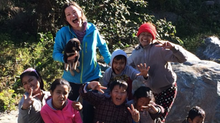Founder, Grainne McKeown's Fall Trip to Nepal
- grain40
- Sep 30, 2013
- 3 min read
Arriving in Bhotechaur September 2013
Spending the last few days at our clinic in Bhotechaur I am reminded of the peace and quiet up here, which always leaves me in awe of the harmony I can feel in my body and mind from returning to a slower pace of life. This morning I took a walk with Devi, the clinic manager to the stone mill. She had harvested corn from the kitchen garden here, dried it in the sun, and now it was ready to be made into flour for chapattis and fry bread. The idea of fresh hot corn bread made me want to be part of the whole process from beginning to end.
At 7am, we walked on the road beyond the clinic, downhill, towards the home of older Sarita, one of the caretakers of the clinic. Stopping there to use the outdoor toilet, I met her daughter who is Bramin caste. She told me she was waiting for the bus to take her to her government office job in Kathmandu. She looked nicely dressed in a clean kurta and pantsuit. I realized, as Devi was telling me, that the community here is quite mixed economically. There are farmers who earn no money all year, who are mostly Tamang caste, and subsist only on eating the food they grow and drinking the milk of their cows if they have one or two. Occasionally they will sell a goat and earn a few rupees for that. These people make up the majority of our patients in the clinic. They come wearing the same set of clothes day after day as it’s the only set they own.
There is then a middle class of people who do have jobs in the city, earning about 8-10,000 NRS per month ($800-$1,000), most of which goes to pay for transportation to and from the city, for food and clothing for the family, and possibly a small amount left over for school fees for one or two children. I watched these families ride their motorcycle, dad plus two-three kids in tow, toward Kathmandu for the day.
Walking toward the mill I began to hear the sound of the cool rushing water coming down from the top of the mountain. A sprightly, ancient-looking man, the miller, with a deeply lined face appeared when Devi called, crawling up from below the bridge to see what we needed. We showed him our corn and he said his top mill was not working that well, so we had better use the one below the bridge. We carefully walked down the stone steps to the where the water came rushing down a second time thanks to the small dam made from a block of wood that the miller had created. The second mill was working well and after pouring the kernels into a wicker basket which funneled the pieces into the center of the mill, the large stone, powered only by rushing water from below, ground the kernels into a fine powder.
The miller typically charges 20 NRS for the use of his mill, which has been here for at least 60 years Devi says. But everyone assists him in the process by helping to gather their own flour brushing the powder, with an ancient wicker brush, from the sides of the stone into a bag to bring back home. I liked this cooperative system where even though you are paying for a service, you still are expected to help out if you can. How different from our own Western way of paying for something and then demanding it be done well for us, quickly and efficiently, or we ask for our money back. When Devi tried to hand the miller 20 rupees, he adamantly refused, saying we do good work for the community by running the free clinic so that’s enough payment for him.












































Comments